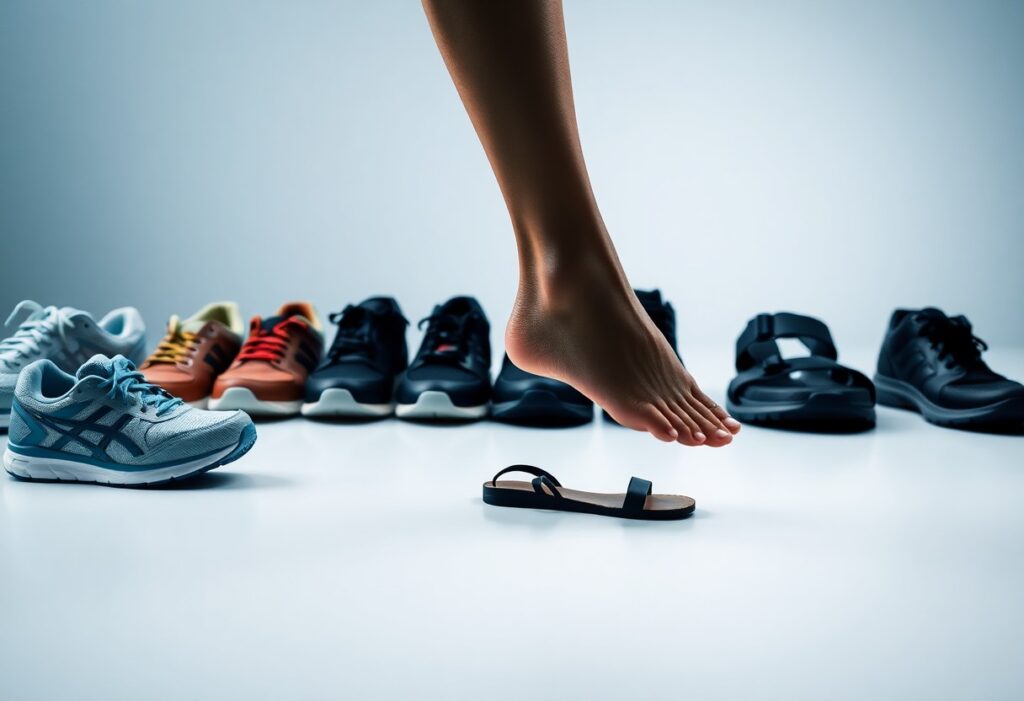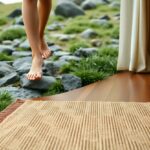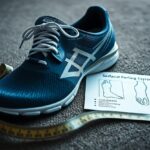
When it comes to walking, the choice of footwear can profoundly influence your foot health. Many people mistakenly think that shoes with more cushioning and support are the best solution for foot pain. However, evidence suggests that traditional footwear may actually lead to more problems than they solve. Dr. Alissa Kuizinas, a respected podiatrist from Massachusetts, promotes the use of barefoot shoes or minimalistic shoes as a healthier alternative, arguing that these types of footwear can strengthen your feet and promote better overall foot health. Choosing shoes that allow your feet to move naturally can significantly reduce the risk of developing numerous foot-related issues while enhancing your overall wellness.
Recognizing the Limitations of Conventional Footwear Choices
While conventional shoes may provide temporary relief from foot discomfort, they often exacerbate existing conditions and introduce new issues, as highlighted by Dr. Alissa Kuizinas. She points out that the $133 billion shoe industry tends to prioritize style and profit over genuine foot health, leading to shoe designs that may constrict and weaken your feet over time. This dependency on traditional footwear can create a detrimental cycle that compromises not only your foot health but your overall physical well-being. Understanding these drawbacks is essential for making informed decisions about your footwear.
Examining the Shoe Industry’s Approach to Foot Health
The shoe industry’s flawed approach to addressing foot health often revolves around adding excessive cushioning, support, and rigid construction to footwear without addressing the root causes of discomfort. This method can cultivate a reliance on traditional shoes that may inadvertently harm your foot health over time, resulting in various complications that could have been prevented with more thoughtful design. It’s crucial to understand how these design choices affect long-term foot wellness and to seek alternatives that promote natural movement.
Evaluating the Common Flaws in Traditional Shoe Designs
Traditional shoes frequently exhibit narrow toe boxes, rigid soles, and an abundance of cushioning, which can restrict natural foot movement and ultimately lead to weak and dysfunctional feet. Dr. Kuizinas emphasizes that shoes should serve to protect your feet from external elements, rather than hinder their natural movement. A well-constructed shoe should encourage natural foot function by incorporating minimalist attributes, including spacious toe boxes, flexible soles, and minimal cushioning to promote overall foot health.
Embracing barefoot shoes or minimalistic footwear can significantly strengthen your feet and improve your overall foot health. Dr. Kuizinas advocates for a philosophy that encourages using as little shoe as possible, which allows your feet to function naturally and move freely. This freedom is essential for maintaining optimal foot mechanics and overall health.
The Essential Importance of Natural Foot Movement
Footwear that limits your foot’s natural movement can lead to various foot problems and discomfort. It’s vital to assess how your shoe choices impact your overall foot health and comfort levels on a daily basis. Understanding this relationship can guide you in making better footwear decisions that support your foot’s natural functions.
Investigating How Shoes Affect Foot Mobility and Function
To fully comprehend how your footwear impacts your foot’s ability to move, it’s essential to scrutinize the specific design features and characteristics of your shoes. Traditional footwear often includes cushioning and support elements that can inadvertently hinder your feet’s natural movement, leading to weak and dysfunctional feet over time. Such limitations can stifle your feet’s development of the necessary strength and flexibility they need to function optimally.
Understanding the Benefits of Allowing Natural Foot Mobility
The benefits of enabling your feet to move naturally are extensive, as strong feet are vital for overall foot health. By opting for minimalistic shoes or barefoot footwear, you empower your feet to perform as intended, fostering strength and resilience. Natural movement is critical for developing strong feet. When your feet are restricted by conventional footwear, the risk of encountering various foot issues and discomfort increases. In contrast, choosing minimalistic shoes or barefoot options can greatly enhance your foot health by allowing for natural movement and supporting strength-building.
Delving into the Concept of Functional Footwear for Optimal Health
Understanding functional footwear is essential as these shoes prioritize both foot health and natural movement. Functional shoes are specifically designed to allow your feet to operate as they are meant to, eliminating the need for excessive support or confinement that can lead to negative health outcomes.
Defining Functional Footwear and Its Key Features
After conducting research and testing various shoe types, you’ll find that functional footwear shares distinct characteristics, such as a wide toe box, flat and flexible soles, and minimal cushioning and support. These features provide your feet the freedom to move freely and naturally, thereby enhancing foot mechanics and overall strength.
Exploring How Functional Shoes Improve Foot Health
Wearing functional shoes offers a multitude of benefits, including enhanced foot strength, reduced injury risk, and improved overall foot health. These shoes facilitate your feet to function as they were designed to, paving the way for stronger feet and better balance during daily activities. Conceptually, functional footwear is crafted to support foot health without imposing unnecessary restrictions, allowing for natural movement and flexibility. By choosing functional options like barefoot shoes or minimalistic designs, you actively promote healthy foot function and lower the risk of foot pain and injury. Transitioning to functional footwear may require time and patience, but the long-term benefits for your foot health are substantial.
Recognizing Key Features of Functional Footwear
To achieve optimal foot health, it is crucial to seek out shoes that come with specific features. The essential attributes to consider include:
- Wide toe box
- Flat and flexible soles
- Minimal cushioning and support
Being aware of these characteristics will significantly assist you in selecting shoes that promote healthy foot function and overall foot wellness.
Understanding the Importance of Wide Toe Boxes and Flexible Soles
A key feature of functional footwear is a wide toe box, which allows your toes to spread naturally. This design prevents toe jamming and other discomfort-related issues that could lead to chronic foot pain. Ensuring that your footwear accommodates natural toe movement is vital for maintaining foot health.
Recognizing the Benefits of Minimal Cushioning and Support
In addition to a wide toe box, functional footwear should feature minimal cushioning and support. This design approach allows your feet to move naturally, thereby strengthening the muscles in your feet and reducing the risk of foot issues. It’s important to emphasize that minimalistic footwear, including barefoot shoes, can greatly enhance your foot health by enabling your feet to function freely. By choosing shoes with minimal cushioning and support, you can bolster muscle strength in your feet and decrease the likelihood of injuries. This strategic approach not only improves your overall foot health but also lowers the chances of experiencing chronic pain over time. Therefore, you should seek out shoes that facilitate natural foot movement without excessive cushioning or support.
Successfully Transitioning to Functional Footwear
Having acknowledged the significance of functional footwear, it’s time to begin your transition. Contrary to the prevalent belief that more cushioning and support equate to better comfort, you should prioritize minimalistic shoes or barefoot shoes that support your feet’s natural functioning and promote healthy mechanics.
Practical Steps for Transitioning to Functional Footwear
Despite any initial concerns, start incorporating functional shoes into your daily routine with these practical strategies:
- Begin with short walks and gradually increase the distance
- Choose shoes with a wide toe box and flat soles
- Opt for minimal cushioning and support
The key is to give your feet time to adapt to the new shoes while simultaneously strengthening the muscles in your feet.
Highlighting the Importance of Patience and Gradual Adjustment
Transitioning to functional footwear requires patience and a gradual approach. Shoes that are overly minimalist may cause discomfort and pain if your feet are not acclimatized to them. Starting slowly is essential, allowing your feet to adjust to the new footwear comfortably. Footwear like barefoot shoes or minimalistic shoes can be incredibly beneficial for your foot health, but introducing them gradually is crucial. Overuse or improper sizing can lead to injuries or ongoing discomfort. The primary goal is to strengthen your foot muscles while enhancing your overall foot health, so exercise patience throughout the transition process. The rewards will be significant, with improvements in balance, reduced pain, and stronger feet.
Fostering Strong and Functional Feet for Lifelong Health
In a world where shoes with excessive cushioning and support are commonplace, it is entirely possible to cultivate strong and functional feet by making informed footwear choices.
Understanding the Impact of Foot Strength on Overall Well-Being
Foot strength is integral to your overall health, influencing your balance, posture, and movement capabilities in conjunction with other health factors. Building strong feet can enhance your physical performance and quality of life.
How Functional Footwear Supports Strong Feet Development
Functionally designed shoes that feature a wide toe box, flat and flexible soles, and minimal cushioning are vital for developing strong feet, as they facilitate natural movement. Indeed, wearing functional shoes or barefoot shoes can significantly contribute to building stronger foot muscles and improving your overall foot health. By allowing your feet the freedom to move and function naturally, you can minimize the risk of foot issues while optimizing your balance and stability. As you transition to minimalistic shoes, you can anticipate improvements in your walking technique and a heightened sense of well-being.
By taking proactive steps towards your foot health, you can select shoes that enhance your feet’s natural functions rather than hinder them. Choosing barefoot shoes or minimalistic options that allow your feet to operate naturally will promote strength development over time. As a result, you will enjoy increased stability and comfort during various activities, providing your feet the opportunity to become strong and capable. Start your journey by looking for shoes with a wide toe box, flat and flexible soles, and minimal cushioning and support, and practice patience as you transition towards a more natural walking style.
The Article A Podiatrist’s Guide to How Shoes Affect Your Foot Health appeared first on My Shoes Finder
The Article How Shoes Impact Your Foot Health: A Podiatrist’s Insights Was Found On https://limitsofstrategy.com





